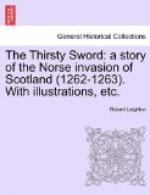Soon from the battlements the six ships of Roderic were seen emerging from the Kyles of Bute, and as they passed Ardmaleish Point, the four galleys of Rothesay dashed out from the bay of Kames, and encountered the enemy. They met him with a rain of well-aimed arrows and showers of missiles. The two ships of Roderic and King Magnus shot ahead, leaving their four consorts behind to engage broadside to broadside with the vessels of Bute, and there followed a terrible sea fight hand to hand — Scots broadsword against Norse battle-axe — that lasted many hours, until the vessels of both sides, much damaged, and with the loss of four score of men and more, found themselves drifted into Rothesay Bay.
From the towers, as he watched the opening of the fight, Earl Kenric espied a band of men marching upon Rothesay from the northward. They were the men of Colonsay, led by Earl Sweyn, who had been reinforced by fifty men from the ships. It was this band whom Aasta had seen setting the deserted homesteads in flames. Sweyn was now bending his course upon Rothesay village.
But, as he came within bow shot, Kenric and his archers were ready. Kenric took careful aim and bent his bow as he had never bent it before. Swiftly the arrow sped with whizzing noise, and it curved in its flight, dropping lower and lower until it dived deep into the bare throat of the Earl of Colonsay. As Sweyn fell, his men saw that the dart had pierced through his neck even to the back of his collarbone, and, enraged at the loss of their master, they ran yet farther. But one by one they staggered and fell, each with an arrow quivering in his broad chest, and those who remained alive took flight beyond range.
And now Kenric turned to watch the ships of Magnus and Roderic, which, with the galley of John of Islay in their wake, were now well within the bay. Driven by their long-sweeping oars, they crept shoreward until their peaked bows grounded in the shallows. The warriors then swarmed over the bulwarks and dropped into the water, wading breast deep to the beach. Kenric’s bowmen from the battlements and from the rising ground above the shore began to assail the bold invaders. But, little daunted, the Norsemen landed in great numbers, taking ashore their besieging engines and various instruments of war.
Then might be seen stones, arrows, quarrels, and other missiles to fly among them, and so effectively did those within the castle exchange their tokens with those without that in one short hour there were many scores of persons wounded, and I know not how many killed. The heaviest of the besieging engines were worked in throwing massive stones, which could be got in plenty and of every size upon the shingly beach. And when there was a good hit, a great shout arose among the invading host. Many shot wagons and three other machines were brought by the enemy — very large, of great power, and very destructive — which might be thought to cut down and crush whatever their missiles struck. But the walls of Rothesay Castle were strong and thick, and the stones that struck them only shivered into a thousand fragments.




